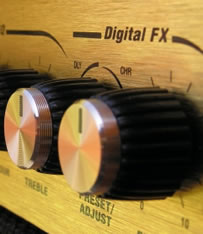Learn To Play Rock Guitar
Beginner rock guitar lessons for n00bs and rusty rockers
Guitar Amp Maintenance
When it comes to guitar amp maintenance, there's not a whole lot you need to worry about with a new amp. The standard tips like:

- Don't pour water all over it or leave it out in the rain
- Don't drop it or play "Gear Toss" with it
- Don't shove mic stands through the speakers
- Don't run heavy equipment over the power chord
…should be pretty obvious. If you don't abuse your amp, it's gonna take care of you when you need it. Ya know, cover it when you're not using it, make sure it's practicing safe s*x (plug it into clean electricity, i.e. use a surge protector). Simple stuff.
This advice goes for all amps, but guitar amp maintenance takes on some special meaning when it comes to tube amplifiers. With solid state, you might have to change a fuse periodically, but with tube amps, it can be a bigger and more expensive job. Tubes can go bad with time and use.
Tubes
Personally, I never experienced a bad tube, but the last thing you want happening is to have your amplifier crap out on you during a potentially career-defining gig. It's a good idea to have spare tubes on hand if you are a performer, just in case.
To give you a leg up on tube guitar amp maintenance, I've put together a list of links to articles to help you keep up with the needs of tube amps:
- Proper Care and Feeding of Tube Amps
- How to Diagnose Your Amp's Bad Tube
- Finding the Tube Amp's "Sweet Spot"
Not only are there guitar amp maintenance tips in these articles, but also some troubleshooting tips for tube amps. Good stuff, Maynard!
If this is a "new2 u" amp, you should've checked the amp out thoroughly before you laid down cash. Maybe you can blow the amplifier cabinet out with a compressor to clear out any dust bunnies. You would have already checked for corrosion on the electronics and made sure everything sounded good. If you have any questions, you can check various online guitar forums or your local music store for answers. Some manufacturers also provide amplifier schematics for techs and electronics wizards.
Some people are into tweaking their gear for performance enhancements. When it comes to custom guitar amp maintenance work, I recommend you take it to someone with a good reputation in your area. Unless you're comfortable with a soldering iron and electronics, leave it to a pro.
Speakers
Speakers, on the other hand, are easy to replace. Why change them out? Like I've said on other pages, using different speakers and cabinets can make a huge difference in your sound. You may want to replace the stock speakers of your cab with better speakers. Make sure you ask around some forums before buying new speakers to make sure they'll work in your amp cab.
Speakers can be expensive to replace. The last thing you want to do is blow them with an amp that is rated with a higher wattage than what the speaker/cabinet is rated. Obviously, with a combo amp, you don't need to worry too much about this since the manufacturer put the speakers in, unless you want or need to replace a speaker.
If you're buying a head and separate cabinet, make sure you check the wattage rating for the cab when you pair it with your amplifier. Here's some info about the importance of matching the right speakers with your amplifier.
Building a speaker video
On a side note, here's a video I found on just how speakers are made. It's pretty cool! Check it out:
Modeling Amps
Modeling amplifiers introduce another form of guitar amp maintenance. In some cases you'll need to update the software on the amps, usually through a USB cable. Just like any computer patch, you'll download the software update and follow the directions to install the update. Definitely not something I ever had to worry about when I started out!
Of course, you can save yourself some guitar amp maintenance trouble and just get a new amp - yea, that's it, get a new one. "If I had a million dollars…"
|
|

